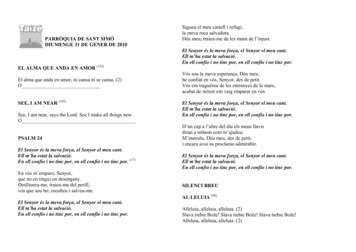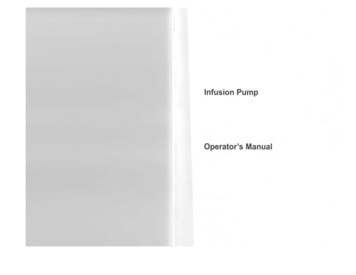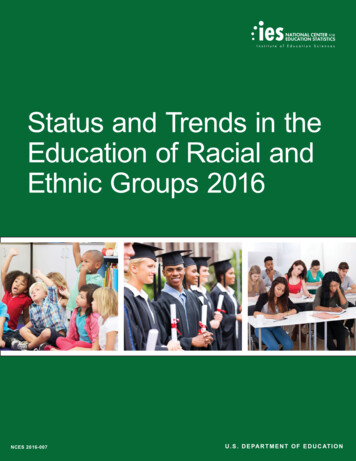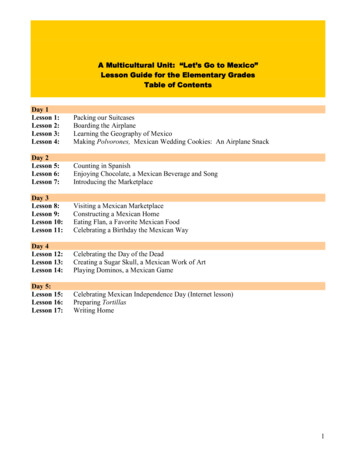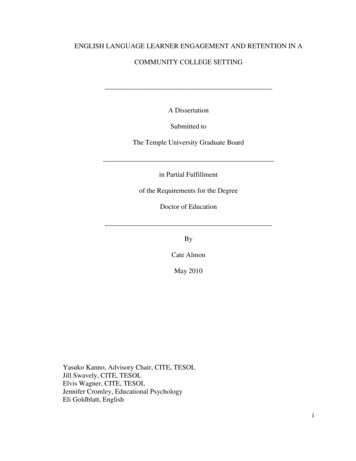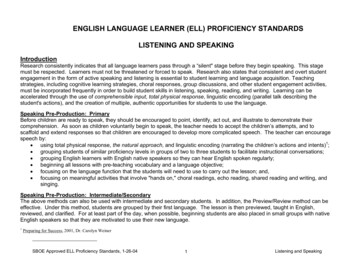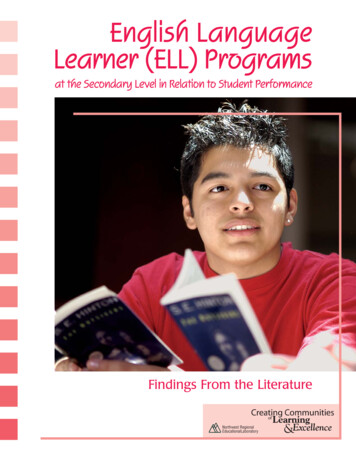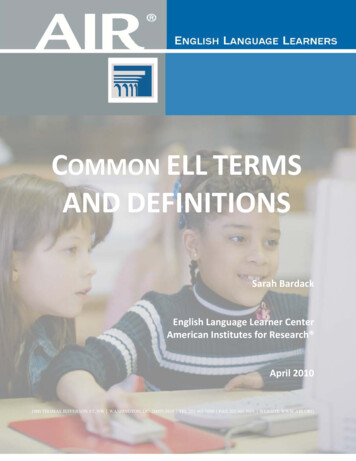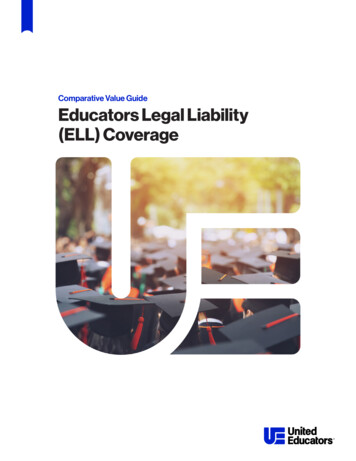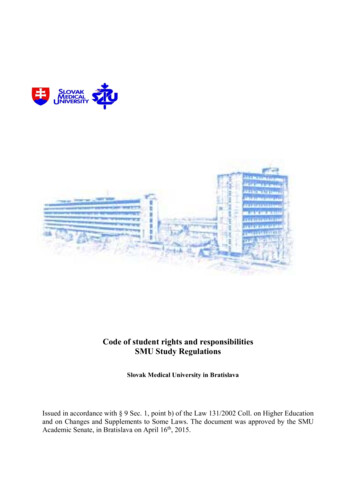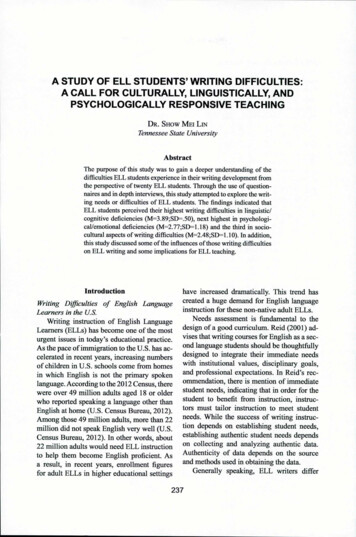
Transcription
A STUDY OF ELL STUDENTS’ WRITING DIFFICULTIES:A CALL FOR CULTURALLY, LINGUISTICALLY, ANDPSYCHOLOGICALLY RESPONSIVE TEACHINGD r . S h o w M e i L inTennessee State UniversityAbstractThe purpose of this study was to gain a deeper understanding of thedifficulties ELL students experience in their writing development fromthe perspective of twenty ELL students. Through the use of question naires and in depth interviews, this study attempted to explore the writ ing needs or difficulties o f ELL students. The findings indicated thatELL students perceived their highest writing difficulties in linguistic/cognitive deficiencies (M 3.89;SD .50), next highest in psychological/cmotional deficiencies (M 2.77;SD 1.18) and the third in socio cultural aspects of writing difficulties (M 2.48;SD 1.10). In addition,this study discussed some of the influences o f those writing difficultieson ELL writing and some implications for ELL teaching.IntroductionWriting Difficulties o f English LanguageLearners in the U.S.Writing instruction of English LanguageLearners (ELLs) has become one of the mosturgent issues in today’s educational practice.As the pace o f immigration to the U.S. has ac celerated in recent years, increasing numbersof children in U.S. schools come from homesin which English is not the primary spokenlanguage. According to the 2012 Census, therewere over 49 million adults aged 18 or olderwho reported speaking a language other thanEnglish at home (U.S. Census Bureau, 2012).Among those 49 million adults, more than 22million did not speak English very well (U.S.Census Bureau, 2012). In other words, about22 million adults would need ELL instructionto help them become English proficient. Asa result, in recent years, enrollment figuresfor adult ELLs in higher educational settingshave increased dramatically. This trend hascreated a huge demand for English languageinstruction for these non-native adult ELLs.Needs assessment is fundamental to thedesign of a good curriculum. Reid (2001) ad vises that writing courses for English as a sec ond language students should be thoughtfullydesigned to integrate their immediate needswith institutional values, disciplinary goals,and professional expectations. In Reid’s rec ommendation, there is mention of immediatestudent needs, indicating that in order for thestudent to benefit from instruction, instruc tors must tailor instruction to meet studentneeds. While the success of writing instruc tion depends on establishing student needs,establishing authentic student needs dependson collecting and analyzing authentic data.Authenticity of data depends on the sourceand methods used in obtaining the data.Generally speaking, ELL writers differ237
238 / College Student Journalfrom native English writers in several ways(Nelson, 1991). Native English writers ac quire English grammatical and linguisticpatterns naturally from their own languageand culture. On the other hand, ELL writersmust acquire these writing skills deliberately,usually as a result of direct instruction. Thismeans that ELL writing samples will probablyhave more surface-level errors in grammar,spelling, mechanics, vocabulary and other lin guistic features than native English-speakingwriters. ELL writers also tend to transfer thennative language patterns from first languageto second language when they are learning tocompose in academic English, especially inthe beginning stages (Nelson, 1991).ELL writing also differs from native writ ing in the ways the ELL writer’s primary lan guage and culture may influence the secondlanguage student’s rhetorical styles, organi zation, and expression of ideas. These ELLlearners must purposely unlearn their nativelanguage writing patterns in order to composein the expected academic American writingstyles. This re-learning process is a complexand difficult task for many adult ELL learners(Swales, 1990).The second language writer’s ideas maybe presented in quite different organizationalpatterns and rhetorical modes than the essen tial linear style that characterizes most Englishwriting (Connor, 1996). The adult ELL stu dent’s unique form or style of written expres sion may not easily conform to the expectedformat, explanation, and organization thatAmerican ELL writing classes require. As aresult, second language writers’ writing sam ples may be misunderstood, undervalued orpoorly evaluated by writing teachers who areunfamiliar with ELL students’ different stylesof rhetorical expression (Hamp-Lyons, 1991).Another important distinction betweenfirst language and second language writerslies in their experience and exposure to aca demic reading and writing tasks throughouttheir lives. Native-born English adult writerswith at least a high school education havebeen exposed throughout their lives to writtenEnglish texts and have practiced academicEnglish writing in some form from elemen tary school to young adulthood. Second lan guage writers, while literate in their nativelanguages, may not have developed a strongliteracy background and experience in writingacademic tasks in their native language orin English. This puts adult ELL learners at adefinite disadvantage when they are trying toacquire good English writing skills in a shortperiod of time (Leki & Carson, 1997).In conclusion, ELL students have differentwriting needs. It is necessary to establish thewriting needs of students for whom Englishis a second language; therefore, compositionteachers can design teaching activities thataddress ELL students’ writing needs and en hance ELL students’ writing process and writ ing performances. Therefore, this study asks,what difficulties do ELL students commonlyexperience in their writing development?MethodSettingThe sample for this study comprisedtwenty volunteer ELL students enrolled in aspring 2011 composition class at an AmericanMidwest University’s Center for English asa Second Language (CESL) program. TheCESL offers an intensive English languageprogram designed for students who wish tomaster English quickly and thoroughly. Over all, CESL offers seven-week sessions in thespring semester, with twenty-five hours ofinstruction per week.Sources o f DataThe researchersThe researcher herself is an ELL writer.She has always struggled for better Englishwriting. Since she came to the U.S. to study,
A Study of ELL Students’ Writing Difficulties / 239most o f her instructors had learning objectivesfor the courses they taught. Most instructorsassumed that since ELL students come to theU.S. to study, they have to learn the languagein order to meet the academic English writ ing standard. As a result, most instructorsset up their learning objectives and learningactivities based on their curricular standardswithout consulting their ELL students’ writ ing needs. As an ELL writer and teacher, Ibegan to question this approach to teachingELL writing, especially with regard to thelearning needs o f ELL students. Through thisstudy, the researcher sought to explore thedifficulties ELL students experience in theirwriting development and how teachers cantailor their teaching to ELL students’ learningneeds to improve their ELL students’ chancesof success in English writing.Data setsThis study combined both qualitative andquantitative methods. The instruments fordata collection included online questionnaires(see appendix 1) and hour-long semi-struc tured personal audio-taped interviews (see ap pendix 2). The first study’s data set includedthe online writing difficulties survey, and thisinstrument was composed of 48 items. Thefirst 6 items related to demographic informa tion and the second 42 items measured eachstudent’s self- perception of his/her writingdifficulties. The demographic items elicitedparticipants’ ages, gender, countries o f birth,native languages, and the number of yearsspent learning English composition. The 42items measuring self-perception of writingdifficulties consisted of three different scales:(a) cognitive/linguistic dimension of writingdifficulties, (b) sociocultural dimension ofwriting difficulties, and (c) psychological/emotional dimension of writing difficulties.Cognitive and linguistic dimensions are dif ferent; but, for many second language adultlearners, writing in a new language involvescombining cognitive and linguistic aspectsof writing simultaneously, making a cleardistinction between linguistic and cogni tive dimensions problematic. There were25 items measuring the cognitive/linguisticdimension of writing difficulties, five itemsmeasuring the sociocultural dimension ofwriting difficulties, and 12 items measuringthe psychological/emotional dimension ofwriting difficulties. The 42 items used a sixpoint Likert-scale, from “strongly disagree”to “strongly agree.” Items were structured sothat the highest score (6) indicated the great est difficulty with an aspect of writing and thelowest score (1) indicated the least difficulty.The second data set consisted ofsemi-structured interviews with ELL writers.In-depth personal interviews, approximatelyone hour in length, were conducted with tenparticipants to explore more deeply the writ ing difficulties and strategies o f dealing withwriting difficulties identified in the onlinequestionnaires. The research tape recorded theinterviews and they were transcribed. To fur ther insure validity, the researcher returned tocontributors when points needed clarification.ParticipantsThe participants in this study consisted oftwenty adult ELL students who were takingELL college composition classes. Among the20 participating students, 11 were male (55%) and 9 female (45%). Participating studentsoriginated from seven countries, includingChina (n 8, 40%), Taiwan (n 4, 20%), SaudiArabia (n 3 ,15%), Angola (n 2,10%), Cam eroon (n l, 5%), Thailand (n l, 5%), andKorea (n l, 5%).Data Analysis ProceduresPrior to scoring the questionnaire items,the researcher put all items on the same scaleby reversing all positively worded statements.This questionnaire was analyzed using de scriptive statistics, such as frequency, means,
240 / College Student Journaland percentages, and inferential statistics.The writing difficulty was represented bysumming up the frequency, percentages, andthe average o f all item mean scores from‘strongly agree’ to ‘strongly disagree’ on theLikert-scale.Online questionnaires provided generalinformation about what difficulties adult ELLstudents experience in their writing process.Interviews supplied more in-depth informa tion because the ELL students’ perceptionswere articulated. The researcher transcribedthe interviews. Next, the researcher coded theinterview narrative by writing key words orphrases that related to the study question inthe margin. These codes were grouped intothemes to discern patterns among ELL stu dents’ perceptions.ResultsMost Difficult Aspects o f WritingThe mean was measured by the averagescore for the total 20 participants in each itemon the questionnaire. The standard deviationwas defined as the measure of the dispersionof the scores from mean for the total 20 par ticipants in each item. In this study, the prima ry criteria used to define items into most andleast difficult categories were mean scores(M 3.54) and standard deviations (SD .44).The mean score of each item larger or equal to4 (3.54 .44 4) constituted placement in themost difficult item category. Table 1 reportsdescriptive data to show the rank of question naire items from strongly agree to stronglydisagree. Over all, 14 items were ranked asthe highest writing difficulties.Participants agreed that word choice (M 5;SD .97) was the chief writing difficulty.Participants indicated in their open-endedquestions that when they were not sure aboutcertain English words, they usually looked upthose words in the bilingual dictionary. How ever, translations from a bilingual dictionaryfrequently came out as a jumble of words tothe students. ELL writers found it very difficultto choose the most appropriate one in a givensentence (context). One participant stated:I had problems of choosing the rightwords to express my ideas. When Ihad difficulties and uncertainties, Ialways looked up those words in mybilingual dictionary. But there were somany translational words coming outfrom my dictionary, I found it was veryhard for me to choose the most appro priate one in a sentence to express mythoughts correctly. (Sue, Self-Percep tion o f Writing Difficulties Question naire, Open-Ended Question 1)Adjusting to American thought patterns(M 4.96; SD 1.08) was the second greatestwriting difficulty. Many participants indicatedthat they had problems adjusting their waysof writing in their first language to Americanthought patterns. Students still thought in thenfirst language and used the rhetorical patternsof their first language to write English es says. Many students expressed that they haddifficulty switching from their first languagerhetorical patterns to English linear rhetoricalpatterns. Because writing patterns or stylesare not only cognitively but also culturallyembedded, many ELL writers in this studyfound it takes a significant amount of timeto adapt to different thinking patterns whencommunicating through written English. Twoparticipants expressed their concerns aboutadjusting to American thought patterns:I had difficulty adjusting my way ofwriting from my native language writ ing to American thought patterns. Forexample, I still had tendency to let myreaders to infer from my writing and Ihad problems of using direct, concise,to the point type of American thoughtpatterns. (Megan, Self-Perception ofWriting Difficulties Questionnaire,Open-Ended Question 1)
A Study of ELL Students’ Writing Difficulties / 241I think I had a lot of problems in orga nizing my ideas in American logic andreasoning. I got used to use my firstlanguage way of writing many fancywords to repeat ideas. I usually wrotemore philosophically and I forgotto provide examples or statements.(Jack, Self-Perception of Writing Dif ficulties Questionnaire , Open-EndedQuestion 1)Writing fluency (M 4.79; SD .88) wasthe third ranked writing difficulty. Studentsstated that they stop many times to thinkabout what to write when they write Englishessays. They often think for extended periodsof time but find only a few words to expressa quite complicated idea; therefore, they haveserious problems with fluency. For instance,one participant said:I usually plan and thought my ideasin my first language and it was notdifficult. But once I have ideas, Istopped many time to think how totranslate my ideas and meaning intoAmerican style of organization, logic,and sentence structure. I often endedup struggling to think for a long peri od of time but could only find simpleand few sentences to express my com prehensive and complicated ideas. Ifelt I had serious problems in writingfluency and I felt I was handicappedto express my ideas fully and fluently.(Nancy, Self-Perception of WritingDifficulties Questionnaire, Open-end ed Question 1)Anxiety (M 4.58; SD 1.18) was thefourth-ranked writing concern. All partic ipants felt anxious about English writing.This anxiety often manifested itself in lowself-confidence in writing, whether in regardto how they organized their ideas or whetherthey could adequately detect their own gram mar errors. Sometimes they emphasized themechanics of writing, sacrificing meaningand creativity. One participant expressed suchanxiety:The more I prepared for the paper,the more confused I got with so manythings going on in my head. How couldI organize my ideas in English in alimited time! But if I couldn’t make itin time, I would get lower grade andmy efforts would be totally ruined!(Wendy, Self-Perception of WritingDifficulties Questionnaire, Open-End ed Question 1)Idioms (M 4.50; SD 1.69) were the fifthmost cited writing difficulty. Participants in dicated that they used few idioms in their En glish writing, often using knowledge of theirfirst language to understand and constructEnglish idioms. In essays they found it hardto be able to memorize and use those idiomswhose meanings were not figuratively trans parent but opaque. In addition, participantsstated that they had problems in using idiomsappropriately; therefore, they used fewer idi oms to avoid slang or colloquialisms in theirwriting. Two participants reported:I was used to use my first language tohelp me to understand and memorizeEnglish idioms. When writing Englishessays, I had problems with memo rizing and using those idioms whoseactual meanings were very differentfrom their literal meanings and my firstlanguage expressions. (Andy, Self-Per ception of Writing Difficulties Ques tionnaire, Open-ended Question 1)I had hard time figuring out whichEnglish idioms were academic writingand which idioms were just colloquialexpressions. Also I had difficulty inusing right idioms at the right placeand at the right time in my sentences;therefore, I tended to use few idioms
2 4 2 / C ollege Student Journalto avoid mistakes. (Jenny, Self-Percep tion of Writing Difficulties Question naire, Open-ended Question 1)a way they deemed appropriate. Participantsthink thesis statements limit their expression.One participant said the following:Low self-confidence (M 4.25; SD 1.69)in English writing was the sixth writing dif ficulty. Most of the participants expressed adeep concern about their low self-confidencein their English writing proficiency. Partici pants felt that their lack of confidence madethem somehow inferior to native speakers andonly added to the nervousness they felt whenwriting English essays. In addition, quite afew participants said they lacked confidencein English writing proficiency in comparisonto their native language writing proficiency.For example, one participant expressed:I have difficulty writing thesis state ments. I don’t see the importance tohave a thesis statement. Summarizingmy ideas in just one sentence is toughfor me. (Garry, Self-Perception ofWriting Difficulties Questionnaire ,Open-Ended Question 1)If I could write in the same way as inArabic, I would feel more confident inmy writing. Now even if I know quitea lot about the topic that teachers giveus to write for my class, I still strugglevery much about how to organize myideas into English essays. I tend to beworried about my sentence structure,grammar, transitional words, and wordchoices. After long hours of writing, Istill write fewer sentences, few para graph in my essay and I feel so badabout my writing. (Mark, Self-Percep tion of Writing Difficulties Question naire, Open-Ended Question 1)Both thesis statement (M 4.21; SD 1.47)and spelling (M 4.21; SD 1.18) were rankedseventh among writing difficulties. In termsof thesis statements, several participants indi cated that writing a thesis statement was dif ficult in English essays. Some of them linkedthe reason why it was difficult to write a thesisstatement to their inability to summarize thenideas into one sentence. Thesis statementswere also considered by participants to be un necessary requirements. Participants felt thatwriters needed to have freedom to write andto express the meaning they wish to convey inWith regard to the difficulty about spell ing, a few participants indicated that Englishis not always spelled as it is pronounced. Therules are complex and there is always an ex ception. The following statement was made:I learn English from listening to nativespeakers. When I spell a word, I tryto match letters with pronunciations.However, in English you often pro nounce in one way, then you write itthe other way. That’s why I alwaysspell wrong. (Hannah, Self-Perceptionof Writing Difficulties Questionnaire,Open-Ended Question 1)Summarizing a large argument into aconclusion (M 4.17; SD 1.13) was the ninthgreatest writing difficulty. Participants feltthat it was difficult to summarize their wholeessay in just one paragraph. They said thatputting a larger piece into a short, conciseparagraph was difficult for them. One partic ipant said:My problem is how to summarize thelong essay I write into conclusion andhow to make it shorter to fit into justone paragraph. That is the most diffi culty that I have. (Lucy, Self-Percep tion of Writing Difficulties Question naire, Open-Ended Question 1)Using prepositions (M 4.08; SD 1.100)was the tenth-most cited writing difficulty.Prepositions were presented as one o f themost troubling aspects o f writing in English.
A Study of ELL Students’ Writing Difficulties / 243Most participants had difficulty using prepo sitions correctly because the participants feltthat every preposition has a number of pos sible meanings and only vague definitions.It is sometimes tremendously difficult forparticipants to decide on a preposition. Oneparticipant expressed:different paragraph). Most of the time,I end up losing my ideas when I try tothink the structure. In the end, I usuallywrite less paragraphs and less sentenc es in my essays. (Nina, Self-Perceptionof Writing Difficulties Questionnaire,Open-Ended Question 1)It was always hard for me to decideappropriate prepositions. When I lookup a preposition in a dictionary, I oftenfind about ten or twenty meanings. Tome, all are very vaguely and confus ingly defined. I don’t know which onethe right choice is. (Mickie, Self-Per ception of Writing Difficulties Ques tionnaire, Open-Ended Question 1)Making grammatical mistakes in sentencefragments (M 4.04; SD 1.16) was the 14thranked writing difficulty. Many participantsindicated that when they wrote, they tendedto think in their first language. Then theytranslated those ideas word-by-word into En glish; therefore, they often ended up writingincomplete sentences and forgetting to followthe mles of English sentence structure. Forexample, Mark expressed:Organization, generating ideas, and para graph conclusion (M 4.04; SD 1.08) tiedfor a ranking as the 11th greatest writingdifficulty. First, with regard to organization,all participants expressed their problems withhaving to follow a specified organizationalpattern in presenting their ideas in Englishwriting. Participants shared that they didnot have experience in following specificAmerican organizational patterns in their firstlanguage writing. Therefore, they felt it un natural to conform their writing to a specificorganizational design. The following are twoparticipants’ statements about organization:I usually just write whatever comes tomy mind about a topic. However, whenI have to do introduction, body, con clusion, and all that, that part botheredme very much. (Sissy, Self-Perceptionof Writing Difficulties Questionnaire,Open-Ended Question 1)It is very hard for me to follow a cer tain structure. I usually spend moretime organizing my ideas to show whatis cause and what is effect. When itcomes to structure, I have to separatemy ideas to go in different place (likeWhen I wrote English essays, I oftenhad a tendency to think my ideas in mynative language first. Then I translatedmy ideas and meaning word-by-wordinto English and I usually forgot to fol low the rules of English sentence struc ture and boundary. As a result, I oftenended up writing many incompletesentences. (Mark, Self-Perception ofWriting Difficulties Questionnaire,Open-Ended Question 1)Linguistic, Psychological, and SocioculturalAspects o f WritingThe mean for linguistic, psychological,and sociocultural aspects of writing was mea sured by the average score for the total 20participants on items categorized on each ofthese specific aspects of writing. The standarddeviation was defined as the measure of thedispersion of the scores from mean for the to tal 20 participants in items categorized in eachof these certain aspects of writing. Furtheranalysis of the data collected from the ques tionnaires showed that ELL students had themost writing difficulty in cognitive/linguisticaspects (M 3.89; SD .50) of writing. The
244 / College Student Journalpsychological/emotional dimension (M 2.77;SD 1.18) of writing was the second writingdifficulty, followed by the sociocultural as pect (M 2.48; SD 1.10) of writing.Conclusions and DiscussionsOver all, the 14 highest ranked writing dif ficulties items fell within all three dimensions.The linguistic/cognitive dimension of writingdifficulties included word choice, stoppingmany times to think, idioms, writing skills,thesis statements, organization, spelling, con clusion, paragraph development, preposition,and sentence structure. The psychological/emotional dimension of writing difficultiesconsisted of anxiety, and adjusting to Americanthought patterns represented the socioculturaldimension of writing difficulties. The findingsof this study are consistent with the previousstudies about ELLs’ writing difficulties. MostELLs thought they had the most writing dif ficulties in cognitive/linguistic deficiencies.However, this study also suggests that ELLshad second-level concems/needs in psycholog ical/emotional writing deficiencies, and thirdin sociocultural writing difficulties. There werefew previous studies focusing on ELLs’ writ ing difficulties in psychological/emotional orsociocultural areas. Even where some studiesexist, there is no order or ranking between thetwo dimensions (psychological/emotional andsociocultural) or three dimensions (cognitive/linguistic, psychological/emotional, and socio cultural). In this study there are some possibleexplanations for having the highest perceivedwriting difficulties in cognitive/linguisticdimension, next highest in psychological/emotional area, and the least as in easiest insociocultural aspects. First, most ELLs’ essaysare scored and given feedback based on lin guistic/cognitive aspects of writing; therefore,ELLs are more likely to look at writing froma linguistic/cognitive lens. Generally speaking,ELLs’ experiences and perceptions of writingare more focused on performance and productwriting. Psychological/emotional or sociocul tural factors of writing may be ignored by, orbe invisible to, most ELLs because these twoareas do not show as scores on their compo sitions, tests, or assignments, nor are studentsgiven feedback on these two areas on writingtests/assignments. For example, among the 14highest writing difficulties, ELLs thought mostof their writing difficulties were in cognitive/linguistic dimensions. There were 10 cogni tive/linguistic writing difficulties identifiedin the present study, including word choice,stopping many times to think, idioms, spelling,paragraph development, preposition usage, andsentence structure. Second, the questionnairein this study was a self-reported type of survey.There were some items regarding psychologi cal/emotional dimensions of writing and thoseitems may prompt ELLs to start thinking aboutthe emotional aspects of their writing, such asanxiety and confidence; therefore, they beganto be aware they had the second most seriousconcerns in psychological/emotional writingdeficiencies. Third, a majority of ELLs wereused to sharing their writings with Englishteachers (the third least writing difficulty) andnative English speakers (the fourth least writ ing difficulty); therefore, they had least diffi culties in sociocultural writing deficiencies.In fact, some of the difficulties could over lap across dimensions. For example, wordchoice and idioms were seen as linguistic/cognitive writing difficulties, but selectingappropriate words and idioms that best ex pressed the meaning intended in a writtencontext went beyond linguistic/cognitivedifficulties to include cultural dimensions ofknowledge. Thesis statements, organization,and paragraph development were in the lin guistic/cognitive dimension of writing, butfollowing an American linear writing stylethat required a thesis, supporting paragraphs,and a conclusion also included culturallyengendered rhetorical issues. Besides thelinguistic/cognitive dimension of writing
A Study of ELL Students’ Writing Difficulties / 245difficulties, these rhetorical writing difficul ties seemed to have their origin in cultural andtraditional differences.The major issue addressed in this studywas the significance of identifying writingdifficulties (needs) from students’ perspec tives (Reid, 2001). Previous studies hadconcentrated more on surveying faculty andanalyzing documents to establish studentlearning needs.to practice the use of these words. Inaddition, teachers can add the confus ing words and usage examples to thestudent’s word book as a resource forthe next paper. Adjusting to American thought pat tern. ELL composition teachers canmodel English thinking and writingto teach English sentence structure.Teachers can use an anonymousstudent’s writing sample papers toexplain the grammar errors causedby the linguistic differences betweenan ELL student’s first language andEnglish so that ELL students can beaware that the English structure dif fers from their first language sentencestructure. Teachers should continueto teach systematically those aspectsof grammar that are still problematic.In addition, teachers can use samplewritings to teach organization, in cluding linearity in discourse devel opment, thesis statements, and unity.ELL students need much practice inorganization to switch from their firstlanguage discourse tradition to theAmerican discourse tradition. Stu dents should be led to see thesis state ments as a statement of the paper’s ar gument or assertion about the subject.Because stating theses and organizingmain points around them may be anew concept for ELL students, plentyof learning exercises may be requiredto help them master and apply thatconcept in their writing. Writing fluency. To help ELL studentsto write fluently and automaticallyto express their ideas, they need afunctional repertoire of vocabulary.Teachers can use a variety of funvocabulary activities to engage stu dents and help them to expand theirImplicationsELL students have learning needs that areELL student-specific. The writing difficultiesexpressed by participants in this study showthat EL
writing (Connor, 1996). The adult ELL stu dent's unique form or style of written expres sion may not easily conform to the expected format, explanation, and organization that American ELL writing classes require. As a result, second language writers' writing sam ples may be misunderstood, undervalued or
